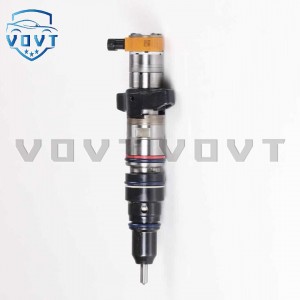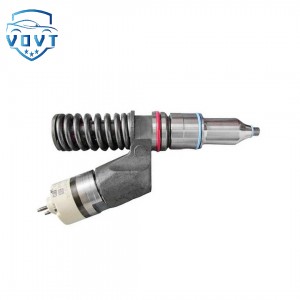New High Quality Diesel Injector 387-9439 20R-8061 387-9438 20R-8060 20R-8062 20R-8068 For CAT C9
Products Description
| Reference. Codes | C9 |
| Application | C9 |
| MOQ | 4PCS |
| Certification | ISO9001 |
| Place of Origin | China |
| Packaging | Neutral packing |
| Quality Control | 100% tested before shipment |
| Lead time | 7~10 working days |
| Payment | T/T, L/C, Paypal, Western Union, MoneyGram or as your requirement |
Example of collaborative optimization of fuel injector and engine control unit
Application of high-pressure common rail system in diesel engine
Case introduction: The high-pressure common rail system consists of a high-pressure oil pump, a common rail chamber, an injector, an electronic control unit, various sensors and actuators, etc. In this system, the injector is opened and closed by a high-speed solenoid valve. The ECU flexibly adjusts the oil pressure in the common rail chamber through the pressure regulating solenoid valve on the high-pressure oil pump according to the engine load condition and the requirements of economy and emission. It can also control the injection timing, injection oil volume and injection rate through the solenoid valve on the injector, and flexibly adjust the injection oil volume of pre-injection and post-injection under different working conditions and the interval with the main injection.
Optimization effect: The injection pressure and injection time can be changed in a wide range, so that the pressure of the high-pressure oil pipe is independent of the engine speed, and the low-speed performance of the engine is optimized; through the coordination of different injection modes such as pre-injection and main injection, the pressure increase rate and peak pressure in the cylinder are reduced, making the engine work more smoothly, while reducing NOx emissions and the possibility of misfire, and improving cold start performance; the injection rate in the middle of the main injection is increased, which can shorten the injection time, increase output power, reduce fuel consumption, and reduce carbon smoke emissions.
Small diesel engine multi-injection parameter collaborative optimization
Case introduction: For a horizontal 2-cylinder non-road stage III emission level small diesel engine, without changing the engine body, the influence of rail pressure, injection timing, pre-injection-main injection interval, and pre-injection amount on diesel engine fuel consumption and emissions is studied, focusing on the influence of rail pressure-injection timing collaborative control on effective fuel consumption rate, NOx emissions and smoke density, and the influence of pre-injection amount-injection interval on engine specific fuel consumption, so as to obtain the best range of each injection parameter, and perform regional local scanning optimization from the perspective of focusing on reducing NOx emissions to obtain the best combination of injection parameters.
Optimization effect: As the rail pressure increases, the diameter of the fuel droplets becomes smaller, and the oil-gas mixing contact area increases, which is conducive to the atomization, evaporation and mixed combustion of the fuel, shortening the physical preparation time required for the combustion of the mixed gas, making the combustion more complete, improving the thermal efficiency, increasing NOx emissions, and reducing the emissions of incomplete combustion products such as soot and CO; in the "pre-injection + main injection" mode, when the injection interval is 1ms, the pre-injection fuel has sufficient time to mix, evaporate and burn with the air, inducing the formation of the main injection flame core, improving the combustion efficiency of the mixed gas, stabilizing the combustion in the cylinder, reducing the engine fuel consumption, and reducing the incomplete combustion products.
Collaborative optimization of piston bowl and injector for light GCI engine
Case introduction: Using computational fluid dynamics (CFD) and advanced machine learning (ML) technology, the piston bowl geometry and injector design of the light GCI engine are collaboratively optimized. 13 design parameters are considered, including 10 piston-related parameters and 3 injector-related parameters. 128 design of experiments (DOE) cases were generated under low, medium and high load conditions, the characteristics and performance of the best design were analyzed, and the best DOE solution was selected by defining a weighted merit, and then further optimized by advanced ML techniques using simulated data sets.
Optimization effect: In low-load partial premixed compression ignition (PPCI) mode, the injector is designed to aim the spray at the upper lip and is divided into a bowl area and a squish area to enhance mixing; in high-load mixed controlled diffusion combustion mode, it is more advantageous to aim the injector at the lower lip; at medium load and high premix ratio, the piston bowl design has limited impact. The optimized injector parameters are that more small-diameter nozzles are used at low load to control the partial premixed charge, and fewer large-diameter nozzles are recommended at high load. Compared with the baseline case, the optimized ML design reduces fuel consumption by 3.8%-4.5% under low and high load conditions.
Continental and Schaeffler Group Micro-Hybrid Technology Concept Car
Case Introduction: Continental and Schaeffler Group replaced the corresponding systems in the reference car by appropriately adjusting the injectors and engine control units manufactured by Continental on the gasoline technology concept car jointly developed. In addition, components such as 48-volt environmentally friendly driving system, electronic clutch and thermal management module are also used, combined with intelligent operation strategies.
Optimization effect: The fuel consumption and CO₂ emissions of the already very efficient Ford Focus sedan (using a 1.0-liter EcoBoost turbocharged small three-cylinder gasoline engine) are reduced by another 17%, while meeting the requirements of the Euro 6c emission standard.
PHINIA 500bar gasoline high-pressure direct injection system
Case Introduction: PHINIA developed the first 500bar gasoline high-pressure direct injection system in the domestic industry, which consists of injectors, high-pressure oil pumps, forged common rails, and corresponding engine control systems and software. In terms of engine control system and software, the processing capacity of ECU is optimized to obtain better fuel supply performance with multiple injection modes, while achieving stricter closed-loop control.
Optimization effect: Compared with the traditional 350bar fuel system, it can significantly reduce the emission of particulate matter in the exhaust gas, helping vehicles to meet more stringent emission standards, such as National VI and even possible National VII standards in the future. At the same time, by injecting fuel at precise intervals, the thermal efficiency of the engine can be further improved and fuel consumption can be reduced.
























